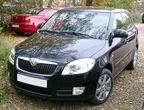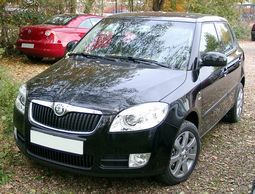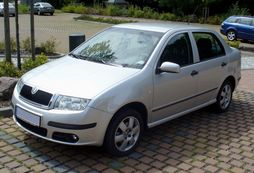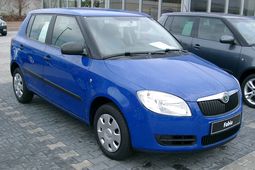The History Of Skoda Fabia

The Škoda Fabia is a supermini produced by Czech manufacturer Škoda Auto since 1999. It was the successor to the Škoda Felicia, which was discontinued in 2001. The Fabia was available in hatchback, estate (named Fabia Combi) and saloon (named Fabia Sedan) body styles while from 2007 merging in the second generation— starting with hatchback and awaiting the new estate version. The saloon variant is not planned for the second generation[citation needed].
The first generation Fabia (given the internal type code 6Y) was officially presented at the Frankfurt Motor Show in September 1999 and production of this model started in October the same year. The estate version Fabia Combi was introduced in September 2000 at the Paris Motor Show. It was the first model to use the Volkswagen Group's A04 platform, which it shares with the Volkswagen Polo Mk IV and SEAT Ibiza.
The range starts with the 1.2 6v Classic (which is cheaper than Volkswagen's smaller 3-door 1.0 Lupo) to the 1.9 PD TDi vRS.
Part of the Fabia's success is the fact that all of its mechanical parts are developed by or in conjunction with Volkswagen, but are offered in a package that is priced to undercut other models in the Volkswagen Group. The only trace of non-VW Škoda left in the Fabia is the 1.4 8v "MPI" Engine, which was a modification to Škoda's own 1.3 engine, and was used in pre-Volkswagen Škodas such as the Estelle and Favorit.
In 2005 the Fabia received a facelift, with changed front fog lights and grille, slightly different rear lights, new steering wheel and revised specification levels. The vRS also had its final gearbox ratio changed. Most importantly the Sport model was added, with the 75PS (55kW) 1.4 petrol being offered with a manual transmission. This engine was quickly dropped for the 1.2 HTP, which was not as powerful but is a much more free revving engine giving a more sporty feel, the sport also had its specification changed to include red seat belts and sunset privacy glass from the B pillar to the rear.
Again in 2006 the Fabia range shown at the Geneva Motor Show had minor specification revisions. These include a center rear head rest, a central three-point seatbelt and an additional four bodywork colours. The 1.4 16v 75PS (55kW) petrol engine was replaced with a more powerful 1.4 16v 80PS (59kW) engine.
Engines
The term MPI (Multi-Point Injection) is used by Škoda to differentiate from 16v models and (in the case of the Octavia) FSI engines. The 75PS (55kW) version of the 1.4 16v was only mated to Volkswagen's four-speed automatic transmission with fuzzy logic operation until the addition of earlier Sport models which mated it with a manual transmission. The 1.4 8v was dropped in 2003 as it will fail to meet future emissions requirements. Its performance is heavily hampered by its old OHV (Pushrod) design. The Fabia's overall performance and fuel consumption figures fall behind other city cars and small family cars as it is larger and heavier. However, the 1.2 HTP (High Torque Performance) Engine was developed specifically for the Fabia and offers better performance and fuel economy, but later used in Volkswagen's own Polo due to its high acclaim.
Trim levels
At launch, the Fabia was available in three trim levels: Classic, Comfort, and Elegance. Later in the Fabia's life the mid-range Comfort Model was dropped for the name Ambiente to fit in with the rest of the range. Other models available throughout the car's lifespan included Ambiente SE, Blackline, Silverline, Sport, Bohemia (Estate only, run-out model) and vRS. Various safety features and minor changes were made over time. Easy and Junior models are sold in Eastern European markets where budgets are lower. Some of these Fabias do not even have painted bumpers or gloveboxes. Also sold in such markets is the Fabia Praktik, which is a panel van version of the Fabia with the rear windows and seats removed. A lesser powered version of the 1.4 MPI with just 60PS (44kW) is also sold in Eastern Europe.
Fabia vRS
Introduced in 2003, the Fabia vRS, while not the first diesel hot hatch, was the first exclusively diesel hot hatch, having no petrol equivalent. The engine is VW Group's 1.9 litre Pumpe-Düse Turbocharged-Diesel producing 130PS (96kW) and 310N·m (229lb·ft) at 1900 rpm, with a six speed manual gearbox. It was named the "Diesel Car of the Year 2003" in the Scottish Car of the Year Awards. It also falls in a low tax band (Band C) in the UK, further increasing its cost benefits over its (chiefly petrol-powered) counterparts.
Official figures state 0 to 100 km/ h (62 mph) takes 9.5 seconds, but several motoring magazines and websites have measured faster times (around the 7.0-7.5 seconds range when remapped by a specialist tuner) (Autocar: 7.1 seconds, Auto Express: 8.1 seconds, and FastHatchbacks.com: 8.5 seconds). The in gear acceleration times are 50-70 mph in 5.6 seconds, quicker than BMW's 330i which takes 6.0 seconds. 20-40 mph in 2.4 seconds is as quick as the Lotus Elise 111R. Despite this the Fabia vRS can achieve better than 5.4L/ 100km (52mpg-imp; 44mpg-US). If driven carefully, some drivers have experienced MPG rates of 68 mpg+ over long periods.[who?]
The vRS was shown to be quicker than a similarly priced MINI Cooper around Top Gear's and Fifth Gear's test tracks.
In 2007 1,000 Special Edition Fabia vRS models were produced featuring individually numbered black leather seats, sporty red brake callipers, Race Blue metallic paint and a 6 CD autochanger. This model was known as the Fabia vRS SE.
The second generation Fabia (internal type code 5J) was officially presented at the Geneva Auto Show in March 2007 and was sold from April 2007. Based on the PQ24 platform like the first generation, it is slightly larger than its predecessor and takes styling cues from the new Roomster leisure activity vehicle.
Škoda UK has created a television advertisement featuring the making of a Škoda Fabia car out of cake while swapped rivets for raisins, metal for marzipan and spark plugs for sugar.
Shanghai Volkswagen Automotive introduces the new Fabia to the public at the 2008 Guangzhou Motor Show. And it will be sold as 2009 model year in China.
The estate variant was officially announced in August 2007 and was introduced at the Frankfurt Motor Show in September 2007. Compared with the first generation the new Combi is 7 mm longer, 46 mm higher higher and the boot has grown by 54 litres (to 480 litres total). The engine portfolio is the same as the hatchback version, without the 1.2 44 kW one.
Engines
The petrol engine lineup is a mixture of newer engines from the Volkswagen Group and some carry overs from the outgoing model. The base 1.2 remains the same (44kW) while the higher powered version has its power output upped to 70PS (51kW). There is only a single 1.4 litre 16v petrol on this model, producing 85PS (63kW). The range topping petrol engine is the 1.6 16v engine producing 105PS (77kW) . There is also an option to link this engine to a 6 speed tiptronic transmission sourced from Aisin.
Diesel engines consist of the same 70PS (51kW) and 80PS (59kW) 1.4 TDI units from before. The range topping diesel is a 1.9 TDI producing 105PS (77kW).
It is rumoured that eventually a 1.4 TSI running at 125PS (92kW) will become the range topping petrol for the planned estate version and that the next generation vRS will also receive the 1.4 TSI to the tune of 170PS (125kW). The release date for the New Fabia vRS has been cited as 2010 by some Škoda UK dealers. Although specs at this date are unknown, it is hoped that the new engine will be a 1.8FSI Petrol producing circa 160bhp.[citation needed]
* with DPF filter
Features
The second generation Fabia trim levels are Classic, Ambiente, Sport and Elegance. In the UK the trim levels are 1, 2, Sport, 3, and Greenline. In India, the trim levels are Active, Classic, Ambiente and Elegance. All models sold within the EU are equipped with front passenger, driver and side airbags. Curtain airbags are available as an option. All models are fitted with a central locking system that automatically locks itself if the keys are not in the ignition and the bonnet gets closed. This is a built-in safety measure to stop people hot-wiring the car then driving off. Also to stop people breaking in if the car was locked by the keys only the keys can open it again meaning no one can break the window and open it from the inside if it was locked by the owner.
Safety
Škoda Fabia passed the Euro NCAP car safety tests with these ratings:
- Adult occupant =
- Child occupant =
- Pedestrian =
Awards
2007: Serbian Car of the Year 2007
From Wikipedia, the free encyclopedia
More About Skoda Fabia



|